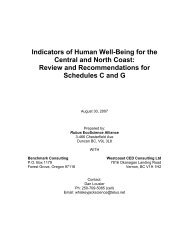Final report - Integrated Land Management Bureau
Final report - Integrated Land Management Bureau
Final report - Integrated Land Management Bureau
You also want an ePaper? Increase the reach of your titles
YUMPU automatically turns print PDFs into web optimized ePapers that Google loves.
Transportation Assessment of the Central & North Coast of BC<br />
BC Hydro has initiated a pilot project to use hydrogen to supplement renewably<br />
generated power in Bella Coola. This is the first of its kind in BC. As a nonintegrated<br />
community, 61 Bella Coola was selected as a test case for using a<br />
hydrogen energy system in remote communities. The project will generate<br />
hydrogen using an electrolyser at times when there is a surplus of renewably<br />
generated electricity at a local run-of-river generating station. The hydrogen<br />
fuel will be stored, and later used during peak demand times. The objective is<br />
to reduce diesel fuel consumption during peak periods.<br />
As part of this initiative, a<br />
hydrogen fuelled truck will<br />
also be operated in Bella<br />
Coola by BC Hydro staff. It<br />
has already been<br />
manufactured, and is<br />
expected to be in use by the<br />
summer of 2009.<br />
Based on our consultation<br />
with representatives from<br />
the Central and North Coast,<br />
there does not yet appear to<br />
be a lot of interest in<br />
adopting non-conventional<br />
vehicles, especially due to<br />
their higher costs at this<br />
juncture. Residents in Prince<br />
Rupert, Kitimat and Bella<br />
Coola use their vehicles to<br />
travel long distances,<br />
transport goods and for recreational purposes. In the island communities,<br />
capacious cars and trucks are often necessary for a multitude of purposes.<br />
These communities could be receptive to having the choice of smaller and/or<br />
alternative fuel cars but are unlikely to abandon larger vehicles for the<br />
foreseeable future.<br />
Should a community choose to adopt alternative-fuel vehicles as part of a move<br />
towards greater environmental sustainability, it would need to undertake a<br />
comparison of technologies and costs. In the case of electric cars, the load<br />
would need to be assessed and the required infrastructure, including the<br />
installation of power points, along with the GHG emissions implications if the<br />
local electrical source is diesel fueled. Given that hydrogen is still an<br />
61 That is, not integrated to BC Hydro main power grid.<br />
Demand for alternative fuel cars is rising in North<br />
America, and the past few years have seen more<br />
research into this mode of transportation and the<br />
adoption of alternative fuel vehicles, sometimes on a<br />
widespread community level. Some examples include<br />
the following.<br />
• Berlin has launched the world's largest<br />
community effort for climate-friendly electric cars,<br />
with the goal of having 100 electric Smart Cars on<br />
the streets by the end of 2009. Five hundred<br />
power-points will be installed, where electric cars<br />
can charge up.<br />
• As part of its plan to be Scotland’s first “green<br />
power” island, the remote Island of Eigg plans to<br />
install solar thermal panels in several homes,<br />
investing in wood fuel business, and buy six<br />
electric vehicles to be leased to residents.<br />
• A developer in Fargo, North Dakota is working<br />
with Global Electrical Motorcars to incorporate<br />
neighborhood electric vehicles as a part of the<br />
green focus of its master planned communities.<br />
Chisholm Consulting 85

















